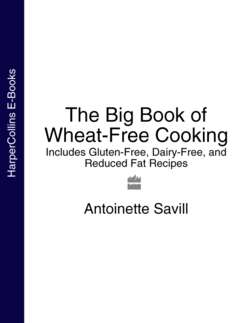Читать книгу The Big Book of Wheat-Free Cooking: Includes Gluten-Free, Dairy-Free, and Reduced Fat Recipes - Antoinette Savill, Antoinette Savill - Страница 16
Introduction to the Recipes
ОглавлениеWith this cookbook, I have tried to balance the number of quick and easy recipes with those that are more time consuming. This should appeal not only to working people with very limited time for entertaining, but also to those juggling a demanding family life. Hopefully, even people who don’t like cooking will enjoy the quick and easy recipes, which I have marked with a Q&E symbol.
I have used various different types or blends of flour in the recipes; some, like Orgran self-raising, are very light, while others, such as rye, are very heavy. This means that if you are using American cup measures and substitute a different flour for that given in the recipe you may need to use your own judgement as to how much to use.
There is a wide range of gluten and wheat-free flour available. My favourite, and the one that I use in many of the recipes, is made by Wellfoods Ltd and is a particularly good mix. It can be purchased by mail order (see here for information) but is not available in the shops yet. Two very good flours that are available in the shops are Doves Farm gluten-free flour and Orgran self-raising flour. You can, of course, mix your own blend to suit but don’t use just one kind of flour, instead mix something like rice flour with potato flour and barley or corn flour (cornstarch), depending on your dietary needs. Please take into consideration that each variety of flour has a different absorbency level and quantities of flour and liquid must therefore be adjusted accordingly. Sometimes you may need to add a little extra liquid if the mixture is too stiff or dry; alternatively, if the mixture is too wet, you may need to add a fraction more flour. If you keep using the same brands or mix of flour, you will soon be able to judge this without a moment’s thought.
In order to balance out the more indulgent and calorific recipes, I have included a substantial number of reduced-fat recipes. Some of them may seem very easy and incredibly healthy but I feel that it is important that in our excitement at being able to bake and cook unlimited delicious meals, we don’t forget the need to have some meals that aid our digestion and that are packed full of nutrients.
In response to the many emails I have received over the past few years, I have tried to incorporate some special requests. For the first time in any of my cookbooks I have indicated when a recipe is suitable for freezing. I have also written a selection of seasonal menus for those of you who find this useful, with some hints on how best to create your own perfectly balanced menus (see here). Thank you to all those who sent emails – it’s great to hear how much my books help.
Throughout the book, all solid and liquid ingredients are given in metric first followed by American imperial and cup measurements. Please follow one set of measurements in each recipe, as they are not interchangeable. All recipes have been tested using each set of measurements.
Please note that where a recipe involves using any specific size of baking tin (pan) or anything other than basic kitchen equipment, this is listed below the ingredients – hopefully this should prevent anyone from beginning a recipe only to discover they don’t have the necessary equipment.
Unless otherwise stated all tablespoon or teaspoon measures are level. All eggs are medium unless otherwise stated. As I think that it makes a substantial difference to the colour, texture and taste of the recipes, I always use organic eggs and chicken. All dairy products are also specified as organic. This is because after a long period of abstaining from dairy, some people – myself included – can tolerate organic dairy products. I believe that this is because chemicals, additives, preservatives, antibiotics and pesticides are not present and hence the body finds it easier to digest the product. Organic products in general have been used in all the recipes but I leave the choice of whether or not you use them to your discretion. A number of the recipes specify particular gluten-free ingredients – these can be purchased in large supermarkets or superstores, health food shops or by mail order.
Before you start a recipe, please look through it carefully and ensure that anyone who may eat it does not have an intolerance to any of the ingredients. It would be so annoying and such a waste of time and money to prepare a dish that one person could not eat!
You will find the recipes organized into groups, usually according to their main ingredient. Where recipes are categorized by the circumstances in which they are usually served, for instance as an appetizer or a breakfast dish, do not feel bound by this – use recipes how you want to use them. An appetizer, for example, can be served as a main course for fewer people, while a breakfast muffin can be a great snack at any time of the day.
I hope these little snippets of information help make wheat-watching easy as well as rewarding.
